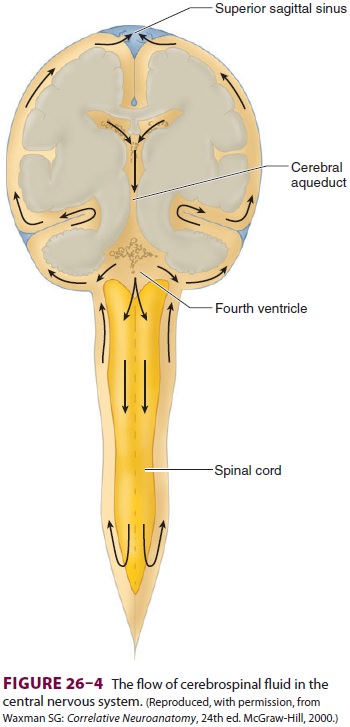Chapter: Clinical Anesthesiology: Anesthetic Management: Neurophysiology & Anesthesia
Cerebrospinal Fluid
CEREBROSPINAL FLUID
CSF is found in the cerebral ventricles
and cisterns and in the subarachnoid space surrounding the brain and spinal
cord. Its major function is to protect the central nervous system (CNS) against
trauma.
Most of the CSF is formed by the choroid
plexuses of the cerebral (mainly lateral) ventricles. Smaller amounts are
formed directly by the ven-tricles’ ependymal cell linings, and yet smaller
quantities are formed from fluid leaking into the perivascular spaces
surrounding cerebral vessels (blood–brain barrier leakage). In adults, normal
total CSF production is about 21 mL/hr (500 mL/d), yet total CSF volume is only
about 150 mL. CSF flows from the lateral ventricles through the
intraventric-ular foramina (of Monro) into the third ventricle, through the
cerebral aqueduct (of Sylvius) into the fourth ventricle, and through the
median aperture of the fourth ventricle (foramen of Magendie) and the lateral
apertures of the fourth ventricle (foram-ina of Luschka) into the
cerebellomedullary cistern (cisterna magna) (Figure26–4). From the cerebello-medullary cistern, CSF enters
the subarachnoid space, circulating around the brain and spinal cord before
being absorbed in arachnoid granulations over the cerebral hemispheres.CSF formation involves active secretion of sodium in the choroid
plexuses. The resulting fluid is isotonic with plasma despite lower potassium,
bicarbonate, and glucose concentrations. Its protein content is limited to the
very small amounts that leak into perivascular fluid. Carbonic anhydrase
inhibitors (acetazolamide), corticosteroids, spirono-lactone, furosemide,
isoflurane, and vasoconstric-tors decrease CSF production.
Absorption of CSF involves the
translocation of fluid from the arachnoid granulations into the cere-bral
venous sinuses. Smaller amounts are absorbed at nerve root sleeves and by
meningeal lymphatics.

Because the brain and spinal cord lack lymphat-ics, absorption
of CSF is also the principal means by which perivascular and interstitial
protein is returned to the blood.
Related Topics